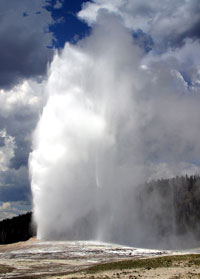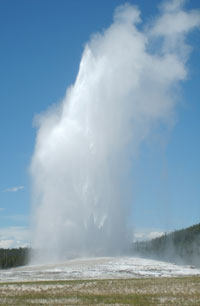  Geyser Facts for Kids Geyser Facts for Kids
Enjoy our wide range of fun geyser facts for kids. Learn how geysers form, the heights geysers can explode to, why geysers are quite rare, areas of the world where geysers are most common, which of the planets in our solar system are believed to have geyser activity on their moons, and much more. | | |
The word geyser comes from the famous Great Geysir in Haukadalur, Iceland. The name for which comes from the Icelandic verb geysa "to gush". There are two types of geysers. Fountain geysers erupt in powerful, often violent bursts from pools of water. While a cone geyser erupts as a steady jet of water from mounds (cones) of geyserite (siliceous sinter) and can last just a few seconds through to several minutes. Geysers don't last forever. If conditions change they can go dormant or become extinct. Geysers have been ruined by people throwing litter and debris into them. Geothermal power plants have been known to reduce the water content and destroy nearby geysers. A geyser's eruptive activity can also change or stop due to ongoing mineral build up within the plumbing system or earthquakes changing the geological dynamics. Yellowstone National Park, USA, is the largest geyser field in the world and home to half of the world's active geysers, in nine geyser basins. Over 1200 geysers have erupted in Yellowstone with an average 465 active in any given year. The world's tallest active geyser is found in Yellowstone. Steamboat Geyser in the Norris Geyser Basin can erupt to a height exceeding 116 m (380 ft). Yellowstone is also home to the world-renowned Old Faithful Geyser. The Valley of Geysers, Kamchatka Peninsula, Russia is the only geyser field in Eurasia (Europe and Asia). With approximately 200 geysers, it has the second largest concentration of geysers in the world. El Tatio (the grandfather) is a valley at 4,200 m (13,800 ft) in the Andes, Chile. It is the 3rd largest geyser field in the world with 80 active geysers. The Taupo Volcanic Zone, North Island, New Zealand is 350 km (217 mi) long by 50 km (31 mi) wide and contains volcanoes, hot springs and geysers. The largest geyser ever known, the Waimangu Geyser, sat in the Taupo Volcanic Zone. It began erupting in 1900 and erupted periodically until a landslide changed the local water table in 1904. Eruptions often reached 160 m (520 ft) with some super bursts hitting 500 m (1,600 ft). Iceland is home to some of the most famous geysers in the world. Geysers and hot springs are distributed all over the country. The Haukadalur geyser field is home to the famous Great Geysir, which still erupts, but very rarely. The nearby Strokkur geyser erupts every 5–8 minutes to a height of around 30 m (98 ft). Eruptions similar to geysers have been seen on the surface of moons in our solar system including Saturn's moon Enceladus and Neptune's moon Triton.
| 

|
|